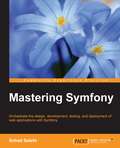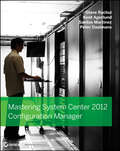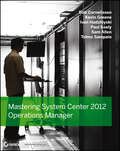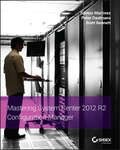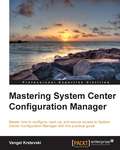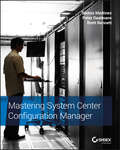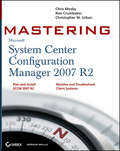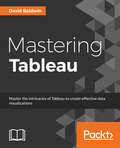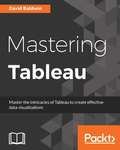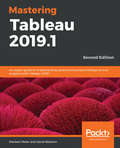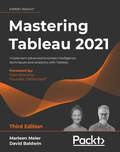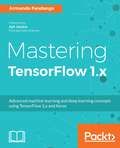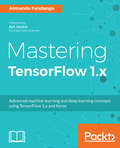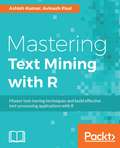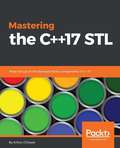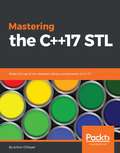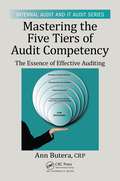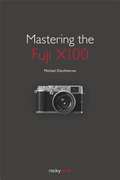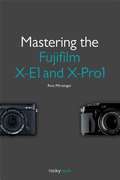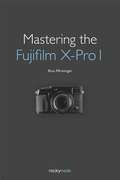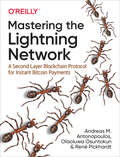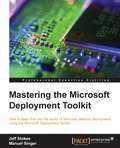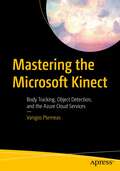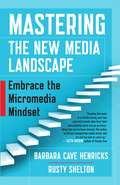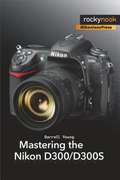- Table View
- List View
Mastering Symfony
by Sohail SalehiOrchestrate the designing, development, testing, and deployment of web applications with Symfony About This Book * Create a robust and reliable Symfony development pipeline using Amazon's cloud platform * Cut development and maintenance costs by defining crystal clear features and possible scenarios for each feature before implementation * Follow detailed examples provided in each chapter to create a task management application Who This Book Is For If you are a PHP developer with some experience in Symfony and are looking to master the framework and use it to its full potential, then this book is for you. Though experience with PHP, object-oriented techniques, and Symfony basics is assumed, this book will give you a crash course on the basics and then proceed to more advanced topics. What You Will Learn * Install and configure Symfony and required third-party bundles to develop a task management application * Set up a continuous integration server to orchestrate automatic builds every time you add a new feature to your project * Reduce maintenance costs dramatically using Behaviour Driven Development (BDD) * Create a slick user interface using the Bootstrap framework * Design robust business logic using Doctrine * Build a comprehensive dashboard and secure your project using the Sonata project * Improve performance using Redis, Memcache, and Varnish * Create customized Symfony commands and add them to your console In Detail In this book, you will learn some lesser known aspects of development with Symfony, and you will see how to use Symfony as a framework to create reliable and effective applications. You might have developed some impressive PHP libraries in other projects, but what is the point when your library is tied to one particular project? With Symfony, you can turn your code into a service and reuse it in other projects. This book starts with Symfony concepts such as bundles, routing, twig, doctrine, and more, taking you through the request/response life cycle. You will then proceed to set up development, test, and deployment environments in AWS. Then you will create reliable projects using Behat and Mink, and design business logic, cover authentication, and authorization steps in a security checking process. You will be walked through concepts such as DependencyInjection, service containers, and services, and go through steps to create customized commands for Symfony's console. Finally, the book covers performance optimization and the use of Varnish and Memcached in our project, and you are treated with the creation of database agnostic bundles and best practices. Style and approach A step-by-step guide to mastering Symfony while developing a task management application. Each chapter comes with detailed examples.
Mastering System Center 2012 Configuration Manager
by Peter Daalmans Kent Agerlund Steve Rachui Santos MartinezExpert coverage of Microsoft's highly anticipated network software deployment toolThe latest version of System Center Configuration Manager (SCCM) is a dramatic update of its predecessor Configuration Manager 2007, and this book offers intermediate-to-advanced coverage of how the new SCCM boasts a simplified hierarchy, role-based security, a new console, flexible application deployment, and mobile management. You'll explore planning and installation, migrating from SCCM 2007, deploying software and operating systems, security, monitoring and troubleshooting, and automating and customizing SCCM 2012 with scripts. Features an unparalleled team of authors, two of whom are insiders at Microsoft and have worked with SCCM since nearly its inceptionProvides in-depth coverage and offers a hands-on approach to learning all there is to know about SCCMExplores why SCCM 2012 is the most significant update in its 16-year historyPacked with real-world scenarios to show you how to use SCCM in various contexts, Mastering System Center Configuration Manager 2012 covers all aspects of this powerful and complete network software deployment tool.
Mastering System Center 2012 Operations Manager
by Bob Cornelissen Paul Keely Kevin Greene Ivan Hadzhiyski Samuel M. Allen Telmo SampaioAn essential guide on the latest version of Microsoft's server management tool Microsoft's powerful Mastering System Center 2012 Operations Manager introduces many exciting new and enhanced feature sets that allow for large-scale management of mission-critical servers. This comprehensive guide provides invaluable coverage to help organizations monitor their environments across computers, network, and storage infrastructures while maintaining efficient and effective service levels across their applications. Provides intermediate and advanced coverage of all aspects of Systems Center 2012 Operations Manager, including designing, planning, deploying, managing, maintaining, and scripting Operations Manager Offers a hands-on approach by providing many real-world scenarios to show you how to use the tool in various contexts Anchors conceptual explanations in practical application Mastering System Center 2012 Operations Manager clearly shows you how this powerful server management tool can best be used to serve your organization's needs.
Mastering System Center 2012 R2 Configuration Manager
by Peter Daalmans Santos Martinez Brett BennettInvaluable coverage on all aspects of System Center 2012 R2 Configuration ManagerCompletely updated for System Center 2012 R2 Configuration Manager, this comprehensive book provides intermediate and advanced coverage of all aspects of the product, including planning and installation, migrating from previous versions of Configuration Manager, deploying software and operating systems, security, monitoring and troubleshooting, and automating and customizing. Provides numerous real-world scenarios to show you how to use the tool in various contextsExplores planning and installation and migrating from SCCM 2007Walks you through deploying software and operating systems, security, monitoring, and troubleshootingDemonstrates automating and customizing SCCM 2012 with scriptsThis essential book provides you with all the information you need to get savvy with System Center 2012 R2 Configuration Manager.
Mastering System Center Configuration Manager
by Vangel KrstevskiThis book is perfect for IT administrators who are looking to enhance their skills on system and asset management. A fair understanding of the core elements and applications related to SCCM would be helpful.
Mastering System Center Configuration Manager
by Santos Martinez Peter Daalmans Brett BennettGet up to date quickly with clear, expert coverage of SCCM 2016 Mastering System Center Configuration Manager provides comprehensive coverage of Microsoft's powerful network software deployment tool, with a practical hands-on approach. Written by Santos Martinez, Peter Daalmans, and Brett Bennett, this guide walks you through SCCM 2016 with in-depth explanations anchored in real-world applications to get you up to speed quickly. Whether you're planning a new installation or migrating from a previous version of Configuration Manager, this book provides clear instruction and expert insight to get the job done right. Fully aligned with the latest release, the discussion covers the newest tools and features with examples that illustrate utility in a variety of contexts. System Center Configuration Manager (formerly SMS) is one of Microsoft's flagship products; the 2016 release has been updated with better Windows 10 and Windows Server 2016 compatibility, improved tools for managing non-Microsoft mobile devices in the cloud, and more. This book provides start-to-finish coverage and expert guidance on everything you need to get your system up to date. Deploy software and operating systems Automate processes and customize configurations Monitor performance and troubleshoot issues Manage security in the cloud and on Virtual Machines SCCM 2016 improves your ability to handle the bring-your-own-device influx in managing mobile, streamlining the latest hiccup right into the everyday workflow. Mastering System Center Configuration Manager provides the practical coverage you need to get up and running seamlessly.
Mastering System Center Configuration Manager 2007 R2
by Chris Mosby Ron D. Crumbaker Christopher W. UrbanMastering System Center Configuration Manager 2007 provides intermediate and advanced coverage of all aspects of the product, including planning and installation, upgrading Systems Management Server 2003, deploying software and operating systems, security, monitoring and troubleshooting, and automating and customizing SCCM 2007 with scripts.The authors take a hands-on approach by providing many real-world scenarios to show readers how to use the tool in various contexts. This anchors the conceptual explanations in practical application. This book's web site will contain a collection of ready-to-use scripts with directions for implementing them in network systems.
Mastering Tableau
by David BaldwinMaster the intricacies of Tableau to create effective data visualizations About This Book * Arm yourself with an arsenal of advanced chart types and geocoding to efficiently and engagingly present information * Map a grid over a network node diagram and use that grid to demonstrate loads, processing time, and more in Tableau * Integrate R with Tableau by utilizing R functions, libraries, and saved models Who This Book Is For If you are a business analyst without developer-level programming skills, then this book is for you. You are expected to have at least a fundamental understanding of Tableau and basic knowledge of joins, however SQL knowledge is not assumed. You should have basic computer skills, including at least moderate Excel proficiency. What You Will Learn * Create a worksheet that can display the current balance for any given period in time * Recreate a star schema from in a data warehouse in Tableau * Combine level of detail calculations with table calculations, sets, and parameters * Create custom polygons to build filled maps for area codes in the USA * Visualize data using a set of analytical and advanced charting techniques * Know when to use Tableau instead of PowerPoint * Build a dashboard and export it to PowerPoint In Detail Tableau has emerged as one of the most popular Business Intelligence solutions in recent times, thanks to its powerful and interactive data visualization capabilities. This book will empower you to become a master in Tableau by exploiting the many new features introduced in Tableau 10.0. You will embark on this exciting journey by getting to know the valuable methods of utilizing advanced calculations to solve complex problems. These techniques include creative use of different types of calculations such as row-level, aggregate-level, and more. You will discover how almost any data visualization challenge can be met in Tableau by getting a proper understanding of the tool's inner workings and creatively exploring possibilities. You'll be armed with an arsenal of advanced chart types and techniques to enable you to efficiently and engagingly present information to a variety of audiences through the use of clear, efficient, and engaging dashboards. Explanations and examples of efficient and inefficient visualization techniques, well-designed and poorly designed dashboards, and compromise options when Tableau consumers will not embrace data visualization will build on your understanding of Tableau and how to use it efficiently. By the end of the book, you will be equipped with all the information you need to create effective dashboards and data visualization solutions using Tableau. Style and approach This book takes a direct approach, to systematically evolve to more involved functionalities such as advanced calculation, parameters & sets, data blending and R integration. This book will help you gain skill in building visualizations previously beyond your capacity.
Mastering Tableau
by David Baldwin<P><P>Mastering Tableau will help you improve your Tableau skills by providing: <P><P>A quick primer to refresh your skills and ensure a sound foundation <P><P>An understanding of how to effectively structure data for best results in Tableau <P><P>Techniques for using Tableau to explore and cleanse data <P><P>A deep dive into Table calculations and LOD calculations <P><P>Insight on various visualization types, how to build them,and when to use them <P><P>Mapping techniques both native and external to Tableau <P><P>Guidance on effective and advanced dashboarding <P><P>Instruction on using Tableau as an effective presentation tool - with or without PowerPoint <P><P>Techniques for improving performance <P><P>Best practices for interfacing with Tableau Server <P><P>A basic understanding of integrating effectively with R
Mastering Tableau 2019.1: An expert guide to implementing advanced business intelligence and analytics with Tableau 2019.1, 2nd Edition
by David Baldwin Marleen MeierBuild, design and improve advanced business intelligence solutions using Tableau’s latest features, including Tableau Prep, Tableau Hyper, and Tableau ServerKey FeaturesMaster new features in Tableau 2019.1 to solve real-world analytics challengesPerform Geo-Spatial Analytics, Time Series Analysis, and self-service analytics using real-life examplesBuild and publish dashboards and explore storytelling using Python and MATLAB integration supportBook DescriptionTableau is one of the leading business intelligence (BI) tools used to solve BI and analytics challenges. With this book, you will master Tableau's features and offerings in various paradigms of the BI domain. This book is also the second edition of the popular Mastering Tableau series, with new features, examples, and updated code. The book covers essential Tableau concepts and its advanced functionalities. Using Tableau Hyper and Tableau Prep, you’ll be able to handle and prepare data easily. You’ll gear up to perform complex joins, spatial joins, union, and data blending tasks using practical examples. Following this, you’ll learn how to perform data densification to make displaying granular data easier. Next, you’ll explore expert-level examples to help you with advanced calculations, mapping, and visual design using various Tableau extensions. With the help of examples, you’ll also learn about improving dashboard performance, connecting Tableau Server, and understanding data visualizations. In the final chapters, you’ll cover advanced use cases such as Self-Service Analytics, Time Series Analytics, and Geo-Spatial Analytics, and learn to connect Tableau to R, Python, and MATLAB. By the end of this book, you’ll have mastered the advanced offerings of Tableau and be able to tackle common and not-so-common challenges faced in the BI domain.What you will learnGet up to speed with various Tableau componentsMaster data preparation techniques using Tableau PrepDiscover how to use Tableau to create a PowerPoint-like presentationUnderstand different Tableau visualization techniques and dashboard designsInteract with the Tableau server to understand its architecture and functionalitiesStudy advanced visualizations and dashboard creation techniquesBrush up on powerful Self-Service Analytics, Time Series Analytics, and Geo-Spatial AnalyticsWho this book is forThis book is designed for business analysts, BI professionals and data analysts who want to master Tableau to solve a range of data science and business intelligence problems. The book is ideal if you have a good understanding of Tableau and want to take your skills to the next level.
Mastering Tableau 2021: Implement advanced business intelligence techniques and analytics with Tableau, 3rd Edition
by David Baldwin Marleen Meier Kate StrachnyiBuild, design, and improve advanced business intelligence solutions using Tableau's latest features, including Tableau Prep Builder, Tableau Hyper, and Tableau ServerKey FeaturesMaster new features in Tableau 2021 to solve real-world analytics challengesPerform geo-spatial, time series, and self-service analytics using real-life examplesBuild and publish dashboards and explore storytelling using Python and R integration supportBook DescriptionTableau is one of the leading business intelligence (BI) tools used to solve data analysis challenges. With this book, you will master Tableau's features and offerings in various paradigms of the BI domain. Updated with fresh topics including Quick Level of Detail expressions, the newest Tableau Server features, Einstein Discovery, and more, this book covers essential Tableau concepts and advanced functionalities. Leveraging Tableau Hyper files and using Prep Builder, you'll be able to perform data preparation and handling easily. You'll gear up to perform complex joins, spatial joins, unions, and data blending tasks using practical examples. Following this, you'll learn how to execute data densification and further explore expert-level examples to help you with calculations, mapping, and visual design using Tableau extensions. You'll also learn about improving dashboard performance, connecting to Tableau Server and understanding data visualization with examples. Finally, you'll cover advanced use cases such as self-service analysis, time series analysis, and geo-spatial analysis, and connect Tableau to Python and R to implement programming functionalities within Tableau. By the end of this Tableau book, you'll have mastered the advanced offerings of Tableau 2021 and be able to tackle common and advanced challenges in the BI domain.What you will learnGet up to speed with various Tableau componentsMaster data preparation techniques using Tableau Prep BuilderDiscover how to use Tableau to create a PowerPoint-like presentationUnderstand different Tableau visualization techniques and dashboard designsInteract with the Tableau server to understand its architecture and functionalitiesStudy advanced visualizations and dashboard creation techniquesBrush up on powerful self-service analytics, time series analytics, and geo-spatial analyticsWho this book is forThis book is designed for business analysts, business intelligence professionals and data analysts who want to master Tableau to solve a range of data science and business intelligence problems. The book is ideal if you have a good understanding of Tableau and want to take your skills to the next level.
Mastering TensorFlow 1.x: Advanced Machine Learning And Deep Learning Concepts Using Tensorflow 1. X And Keras
by Armando FandangoWe cover advanced deep learning concepts (such as transfer learning, generative adversarial models, and reinforcement learning), and implement them using TensorFlow and Keras. We cover how to build and deploy at scale with distributed models. You will learn to build TensorFlow models using R, Keras, TensorFlow Learn, TensorFlow Slim and Sonnet
Mastering TensorFlow 1.x: Advanced machine learning and deep learning concepts using TensorFlow 1.x and Keras
by Armando Fandango Nick McClureBuild, scale, and deploy deep neural network models using the star libraries in Python Key Features Delve into advanced machine learning and deep learning use cases using Tensorflow and Keras Build, deploy, and scale end-to-end deep neural network models in a production environment Learn to deploy TensorFlow on mobile, and distributed TensorFlow on GPU, Clusters, and Kubernetes Book Description TensorFlow is the most popular numerical computation library built from the ground up for distributed, cloud, and mobile environments. TensorFlow represents the data as tensors and the computation as graphs. This book is a comprehensive guide that lets you explore the advanced features of TensorFlow 1.x. Gain insight into TensorFlow Core, Keras, TF Estimators, TFLearn, TF Slim, Pretty Tensor, and Sonnet. Leverage the power of TensorFlow and Keras to build deep learning models, using concepts such as transfer learning, generative adversarial networks, and deep reinforcement learning. Throughout the book, you will obtain hands-on experience with varied datasets, such as MNIST, CIFAR-10, PTB, text8, and COCO-Images. You will learn the advanced features of TensorFlow1.x, such as distributed TensorFlow with TF Clusters, deploy production models with TensorFlow Serving, and build and deploy TensorFlow models for mobile and embedded devices on Android and iOS platforms. You will see how to call TensorFlow and Keras API within the R statistical software, and learn the required techniques for debugging when the TensorFlow API-based code does not work as expected. The book helps you obtain in-depth knowledge of TensorFlow, making you the go-to person for solving artificial intelligence problems. By the end of this guide, you will have mastered the offerings of TensorFlow and Keras, and gained the skills you need to build smarter, faster, and efficient machine learning and deep learning systems. What you will learn Master advanced concepts of deep learning such as transfer learning, reinforcement learning, generative models and more, using TensorFlow and Keras Perform supervised (classification and regression) and unsupervised (clustering) learning to solve machine learning tasks Build end-to-end deep learning (CNN, RNN, and Autoencoders) models with TensorFlow Scale and deploy production models with distributed and high-performance computing on GPU and clusters Build TensorFlow models to work with multilayer perceptrons using Keras, TFLearn, and R Learn the functionalities of smart apps by building and deploying TensorFlow models on iOS and Android devices Supercharge TensorFlow with distributed training and deployment on Kubernetes and TensorFlow Clusters Who this book is for This book is for data scientists, machine learning engineers, artificial intelligence engineers, and for all TensorFlow users who wish to upgrade their TensorFlow knowledge and work on various machine learning and deep learning problems. If you are looking for an easy-to-follow guide that underlines the intricacies and complex use cases of machine learning, you will find this book extremely useful. Some basic understanding of TensorFlow is required to get the most out of the book.
Mastering Text Mining with R
by Avinash Paul Ashish KumarMaster text-taming techniques and build effective text-processing applications with R About This Book • Develop all the relevant skills for building text-mining apps with R with this easy-to-follow guide • Gain in-depth understanding of the text mining process with lucid implementation in the R language • Example-rich guide that lets you gain high-quality information from text data Who This Book Is For If you are an R programmer, analyst, or data scientist who wants to gain experience in performing text data mining and analytics with R, then this book is for you. Exposure to working with statistical methods and language processing would be helpful. What You Will Learn • Get acquainted with some of the highly efficient R packages such as OpenNLP and RWeka to perform various steps in the text mining process • Access and manipulate data from different sources such as JSON and HTTP • Process text using regular expressions • Get to know the different approaches of tagging texts, such as POS tagging, to get started with text analysis • Explore different dimensionality reduction techniques, such as Principal Component Analysis (PCA), and understand its implementation in R • Discover the underlying themes or topics that are present in an unstructured collection of documents, using common topic models such as Latent Dirichlet Allocation (LDA) • Build a baseline sentence completing application • Perform entity extraction and named entity recognition using R In Detail Text Mining (or text data mining or text analytics) is the process of extracting useful and high-quality information from text by devising patterns and trends. R provides an extensive ecosystem to mine text through its many frameworks and packages. Starting with basic information about the statistics concepts used in text mining, this book will teach you how to access, cleanse, and process text using the R language and will equip you with the tools and the associated knowledge about different tagging, chunking, and entailment approaches and their usage in natural language processing. Moving on, this book will teach you different dimensionality reduction techniques and their implementation in R. Next, we will cover pattern recognition in text data utilizing classification mechanisms, perform entity recognition, and develop an ontology learning framework. By the end of the book, you will develop a practical application from the concepts learned, and will understand how text mining can be leveraged to analyze the massively available data on social media. Style and approach This book takes a hands-on, example-driven approach to the text mining process with lucid implementation in R.
Mastering the C++17 STL
by Arthur O 'DwyerModern C++ has come a long way since 2011. The latest update, C++17, has just been ratified and several implementations are on the way. This book is your guide to the C++ standard library, including the very latest C++17 features. By the end of the book you will be proficient in using the C++17 STL to implement real programs, and you\\\\\\\\\\\\\\\'ll have a solid understanding of the library\\\\\\\\\\\\\\\'s own internals.
Mastering the C++17 STL
by Arthur O'DwyerThis book breaks down the C++ STL, teaching you how to extract its gems and apply them to your programming. About This Book • Boost your productivity as a C++ developer with the latest features of C++17 • Develop high-quality, fast, and portable applications with the varied features of the STL • Migrate from older versions (C++11, C++14) to C++17 Who This Book Is For This book is for developers who would like to master the C++ STL and make full use of its components. Prior C++ knowledge is assumed. What You Will Learn • Make your own iterator types, allocators, and thread pools. • Master every standard container and every standard algorithm. • Improve your code by replacing new/delete with smart pointers. • Understand the difference between monomorphic algorithms, polymorphic algorithms, and generic algorithms. • Learn the meaning and applications of vocabulary type, product type and sum type. In Detail Modern C++ has come a long way since 2011. The latest update, C++17, has just been ratified and several implementations are on the way. This book is your guide to the C++ standard library, including the very latest C++17 features. The book starts by exploring the C++ Standard Template Library in depth. You will learn the key differences between classical polymorphism and generic programming, the foundation of the STL. You will also learn how to use the various algorithms and containers in the STL to suit your programming needs. The next module delves into the tools of modern C++. Here you will learn about algebraic types such as std::optional, vocabulary types such as std::function, smart pointers, and synchronization primitives such as std::atomic and std::mutex. In the final module, you will learn about C++'s support for regular expressions and file I/O. By the end of the book you will be proficient in using the C++17 standard library to implement real programs, and you'll have gained a solid understanding of the library's own internals. Style and approach This book takes a concise but comprehensive approach to explaining and applying the C++ STL, one feature at a time.
Mastering the Five Tiers of Audit Competency: The Essence of Effective Auditing (ISSN)
by Ann ButeraRisk-based operational audits and performance audits require a broad array of competencies. This book provides auditors and risk professionals with the understanding required to improve results during risk-based audits.Mastering the Five Tiers of Audit Competency: The Essence of Effective Auditing is an anthology of powerful risk-based auditing pra
Mastering the Fuji X100
by Michael DiechtierowMastering the Fuji X100 provides the ambitious photographer with everything they need to know to operate this camera that has become an instant classic. Readers will learn about the features and capabilities of the X100 and will discover numerous tips and tricks for how to maximize its potential. Learn how to influence dynamic range, how to optimize focus, which film simulation is best, and much more. The Fuji X100 is a premium digital viewfinder camera that combines compact size with sophisticated technical features and uncompromising optical quality. This unique camera already enjoys cult status and is used by many photographers as the ideal travel and snapshot camera. Nonetheless, the X100 is much more than an automatic snapshot camera--it is a sophisticated photographic tool. In a layout suitable to the camera's attractive design, this manual presents convincing imagery that attests to the fun you will have as you begin to push the envelope of your Fuji X100.
Mastering the Fujifilm X-E1 and X-Pro1
by Rico PfirstingerMastering the Fujifilm X-E1 and X-Pro1 provides a wealth of experienced-based information and insights for owners of Fuji's mirrorless X-E1 and X-Pro1 system cameras. Readers will learn about the features and capabilities of these cameras and will discover numerous tips and tricks for how to maximize their potential. The book also covers lenses and key accessories, as well as various post-processing options. With the X-E1 and X-Pro1, Fujifilm released two affordable mirrorless system cameras with APS-C sensors that rival modern full-frame cameras. The successful combination of high-end retro design and state-of-the-art digital camera technology, originally seen in the X100 viewfinder camera, has now been pushed even further. The systems offer a number of FUJINON interchangeable zoom and prime lenses, and several more have been announced. In a layout suitable to the cameras' attractive design, this manual presents imagery that attests to the fun you will have as you begin to push the envelope of your Fujifilm X-E1 or X-Pro1.
Mastering the Fujifilm X-Pro 1
by Rico PfirstingerMastering the Fujifilm X-Pro 1 provides a wealth of experienced-based information and insights for owners of the new X-Pro 1 camera. Readers will learn about the features and capabilities of the X-Pro 1 and will discover numerous tips and tricks for how to maximize its potential. With the X-Pro 1, Fujifilm released the first mirrorless camera with an APS-C sensor. The successful combination of high-end retro design and state-of-the-art digital camera technology, originally seen in the X100 viewfinder camera, has been pushed even further to achieve this interchangeable-lens camera. The X-Pro 1 offers three FUJINON interchangeable lenses. In a layout suitable to the camera's attractive design, this manual presents imagery that attests to the fun you will have as you begin to push the envelope of your Fujifilm X-Pro 1.
Mastering the Lightning Network
by Andreas M. Antonopoulos Olaoluwa Osuntokun René PickhardtThe Lightning Network (LN) is a rapidly growing second-layer payment protocol that works on top of Bitcoin to provide near-instantaneous transactions between two parties. With this practical guide, authors Andreas M. Antonopoulos, Olaoluwa Osuntokun, and Rene Pickhardt explain how this advancement will enable the next level of scale for Bitcoin, increasing speed and privacy while reducing fees.Ideal for developers, systems architects, investors, and entrepreneurs looking to gain a better understanding of LN, this book demonstrates why experts consider LN a critical solution to Bitcoin's scalability problem. You'll learn how LN has the potential to support far more transactions than today's financial networks.This book examines:How the Lightning Network addresses the challenge of blockchain scalingThe Basis of Lightning Technology (BOLT) standards documentsThe five layers of the Lightning Network Protocol SuiteLN basics, including wallets, nodes, and how to operate oneLightning payment channels, onion routing, and gossip protocolFinding paths across payment channels to transport Bitcoin off-chain from sender to recipient
Mastering the Microsoft Deployment Toolkit
by Manuel Singer Jeff StokesTake a deep dive into the world of Windows desktop deployment using the Microsoft Deployment Toolkit About This Book * Learn Microsoft Deployment Toolkit best practices and how to adopt them into your deployment project * Troubleshoot task sequence errors and quickly resolve deployment blockers * An easy-to-follow, in-depth guide to image creation, customization, and deployment of Windows Who This Book Is For This book is ideal for those deploying or planning to deploy Windows, in need of a top-to-bottom guide on project deployment. It is also an invaluable resource for consultants who need a top-to-bottom guide (or just a refresher) on project deployment. What You Will Learn * Build a production-ready MDT environment * Administer the environment for multiple users * Customize your reference image with an MDT Task Sequence * Create standalone media for offline deployments * Customize the default user profile according to the version of Windows * Get to grips with some troubleshooting steps and processes to reduce the time for recovery of a failed image * Customize and create Windows images for deployment * Discover useful tips and tricks to help save time in your deployment projects In Detail The Microsoft Deployment Toolkit (MDT) provides a comprehensive collection of tools, processes, and guidance for automating desktop and server deployments. It considerably reduces deployment time and standardizes desktop and server images. Moreover, MDT offers improved security and ongoing configuration management. Microsoft Deployment Toolkit is the official supported method of creating and customizing Windows images for deployment. Starting from scratch, this book walks you through the MDT setup, task sequence creation, and image deployment steps in detail. Breaking down the various MDT concepts, this book will give you a thorough understanding of the deployment process. Beginning with imaging concepts and theory, you will go on to build a Microsoft Deployment Toolkit environment. You will understand the intricacies of customizing the default user profile in different versions of Windows. Driver handling can be a challenge for larger organizations; we'll cover various driver concepts including mandatory driver profiles. ]Other important topics like the User State Migration Tool (USMT), configuration of XML files, and how to troubleshoot the USMT are also discussed in the book. We will cover the verifier and Windows Performance Toolkit for image validation scenarios. Furthermore, you will learn about MDT web frontend implementation as well as how to utilize the database capabilities of MDT for deeper deployment options. We'll wrap it all up with some links to resources for more information, blogs to watch, and useful Twitter handles. Style and approach This is a comprehensive guide written using a step-by-step approach. It begins with the basics and gradually moves on to the advanced topics MDT.
Mastering the Microsoft Kinect: Body Tracking, Object Detection, and the Azure Cloud Services
by Vangos PterneasKnow how to program the Microsoft Kinect and use the device for applications that interact directly with humans through gestures and motion. This book covers the mathematics and theoretical background needed for depth sensing, motion tracking, and object recognition while maintaining a practical focus on getting things done. You will learn to track the human body in three-dimensional space, analyze the human motion, and remove the background to isolate the person being tracked. You will see how to recognize objects and voice, and transform between the three-dimensional physical space and a computer’s two-dimensional screen.The book is written with real-world applications in mind. It provides step-by-step tutorials and source code for common use cases. The author has worked with startups and Fortune 500 companies, and all of the examples are taken directly from the industry. The book’s practical focus simplifies the core principles, removes the clutter, and allows developers to start writing code right away. Also covered is the use of Azure Cognitive Services on Microsoft’s cloud platform and their use for object and voice recognition, enabling your applications to “see” objects and respond to their environment.What You Will LearnVisualize color, depth, and body dataCalculate angles between different body jointsAnalyze human motion and create fitness applicationsRecognize objects and voice using cloud-powered artificial intelligenceRemove the background from a scene to create virtual worldsWho This Book Is ForDevelopers who want to build demanding Kinect apps and games, and those who are looking for a careful balance between theoretical knowledge and practical application that favors the practical. Readers should have a basic knowledge of C# and some familiarity with the Unity3D engine.
Mastering the New Media Landscape
by Rusty Shelton Barbara Cave HenricksThe New Way to Get Noticed The giant brands that once dominated the media landscape--Oprah, the New York Times, NPR, CNN--have seen their monopoly on public attention smashed by the Internet and now find themselves competing with individuals and brands in a sea of micromedia: websites, social media, blogs, podcasts, and more. Ace publicists and marketers Barbara Cave Henricks and Rusty Shelton show that to navigate through this modern terrain, you need to think more like a media executive than a marketer. The key lies in mastering three crucial categories of media--earned, owned, and rented--and knowing how to integrate each for maximum success. By using this proven strategy, you can create a positive feedback loop that will generate massive momentum and grow a large, loyal audience for your message.
Mastering the Nikon D300/D300S
by Darrell Young<p>Mastering the Nikon D300/D300S, by Darrell Young, provides a wealth of experience-based information and insights for owners of these powerful and sophisticated cameras. Darrell is determined to help the user navigate past the confusion factor that often comes with complex but powerful new professional camera equipment.<br/><br/>\nThe book explores the features and capabilities of the two cameras in a way that completely surpasses user's manuals. It guides readers through the DSLR camera features with step-by-step setting adjustments, color illustrations, and detailed explanations for each option. Each button, dial, switch, screen, and menu configuration option is explored in a user-friendly manner, with suggestions for setup according to various shooting styles.<br/><br/>\nDarrell Young's friendly and informative writing style allows readers to easily follow directions, while feeling as if a friend dropped in to share his knowledge. The learning experience for D300/D300S beginners-and refresher information for professionals-goes beyond just the camera itself. Detailed explanations cover White Balance, the Histogram, the Multi-CAM 3500DX autofocus system, and how the Live View and D-Movie modes work. Camera accessories such as Speedlight flash and GPS units are also considered.</p>
